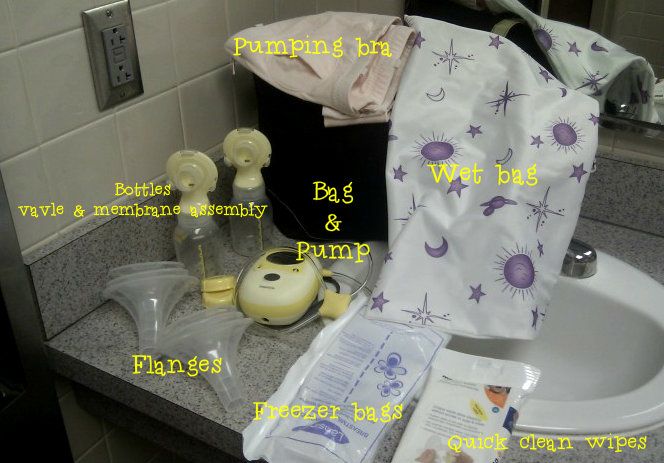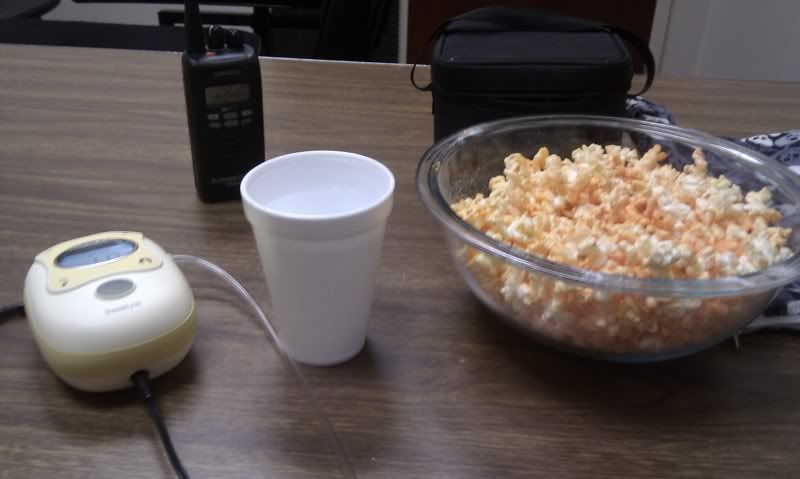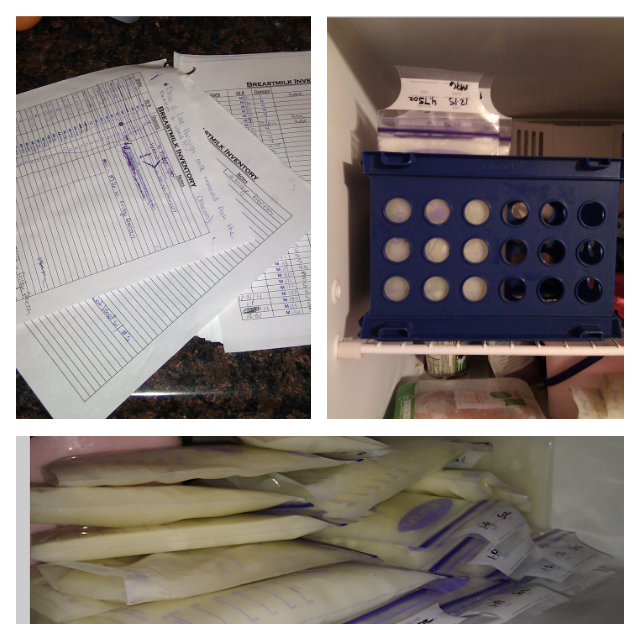In Part I of my Breastfeeding, Pumping, Working Mom series I introduced you to some information that will get you started in the right direction to be successful at continuing the breastfeeding relationship with your child once you return to work. Now I would like to introduce you to how I manage it!
I work 10 hour shifts 4 days per week. I'm a telecommunicator for a police agency. There are always two of us on duty at a time (during the times I work at least) so when one breaks the other handles the job. There is no predicting what will or will not happen so taking a lunch or pump break is a gamble. Always has been, always will be. We just hope the worst holds out til the other can get back! I sometimes try to take a portable radio with me so I can keep up with how busy things may get.
A well-rounded pump break
I have the Medela Freestyle pump which comes with a very convenient shoulder bag. It also comes with a small cooler that I sometimes carry with me to place my bags of pumped milk in for discrete and more sterile storage in the refrigerator.
The pump takes up next to no room in the bag leaving plenty of space for (my) necessities:
- Pump, tubing, and charger/batteries - You really can't pump without the pump...
- Flanges, valves and membranes - Other essential parts to the pumping process!
- Nursing pads - I prefer the disposable Lansinoh nursing pads. I do have some reusable pads but they don't fit very discretely, at least not the ones I own. I'm considering purchasing a better brand.
- Lanolin cream... just in case - Pumping can be kind of rough for first timers or anybody with cracks or cuts so using lanolin to help lubricate the flange/nipple may come in handy.
- Extra storage bottles or freezer bags - I only carry two pump bottles with me (with lids) and a stash of freezer bags. I pump in to the bottles then transfer to the bags.
- A ballpoint pen - You will want this to label your storage bags
- Wet bag or large Ziploc bag - I use a small wet bag (like you'd use for cloth diapers or swim suits) to store my pump parts in.
- Hands-free pumping bra - That says it all!
- Hand/Paper towel - When I take my bra off and remove the flanges milk always drips. Even if I do my best to get everything in to the bottle it is inevitable. Laying down a hand towel or burp rag for you to put on your lap/table to catch the drippies is a helpful tool.
- Quick clean wipes - I use the Medela brand.
- Baby clothing item or baby photo - Having a baby clothing item such as a receiving blanket or a photo of your baby with you can help your pumping output and inhibit letdown. I personally do not do this with my son but did it with my daughter.

A typical night of pumping at work:
With my son I started back to work at 4 weeks post-partum. At that point my milk supply had not really leveled out and I got engorged fairly quickly. I pumped 3-4 times per night every couple of hours if possible. I hated (and still slightly dislike) pumping... My son hated not having mommy so the feeling was mutual! He wasn't eating much and once again I was way over-producing. After a couple of weeks I reduced pumping to 2-3 times per night. At the same time my son began to take bottles a little better and got on a more normal routine. I have been back to work about 3 months. I typically pump in the middle of my shift and then again when I get home at night. Sometimes I will manage to pump twice per shift and not have a need to pump once I get home. I have been maintaining my supply this way for approximately a 4 weeks.
My son will take anywhere from 10-16 ounces when I'm working. I pump between 14-20 ounces per shift.
***Keep in mind that I over produce considerably in terms of average pumping output. In 15 minutes I can get upwards of 10oz total. Some people will get far less, and there are a few that could get far more especially if you have more time. It will also depend on how long it has been since you last pumped/nursed.
This link will give you an idea of what is normal and what is abnormal: I'm not pumping enough milk. What can I do?***
Storing your pumped milk:
I transfer my milk in to freezer bags once I'm finished pumping. I date my bags, list how many ounces are in the bag and give the bag an inventory number. Yes, I inventory my milk. There is a slight obsession I have with keeping count of how much milk I have in my freezer. I'll get to that in a minute.In the early weeks they suggest you freeze/store in small increments, like 2 ounces, because in all likelihood your baby will not eat that much if you introduce a bottle early, and they don't want you to risk wasting milk by thawing out too much. I always store in 4-5 ounce increments. The Lansinoh storage bags I use hold up to 6 ounces but to be safe 4 to 5 is my preferred maximum. That works for us. You can follow the Breastmilk Storage & Handling guidelines to help make the choice of how many ounces per bag you'd like to freeze.
At the end of the night I come home, add the milk I pumped to inventory sheets I have printed then place them in the freezer. I printed out several pages of an Excel spreadsheet that has Date, Inventory #, Ounces, and a column for notes. That milk then goes in my kitchen freezer before later going in to the deep freezer (which is inconveniently placed in an outside closet). I sort my milk in rows sequenced by inventory number. About 15 or so bags are put in a small basket that I set in the kitchen freezer for my husband to have easy access to throughout my work week, and also limits how often the deep freezer is open. He thaws one bag at a time as he needs them.
My milk is used on a rotation ensuring I go back and use the oldest milk first. Breastmilk can be properly stored in a deep freezer for 6-12 months. Rotating my milk will keep anything from going bad that way down the road I can donate the freshest milk possible when Maddox weans or I decide to stop giving him expressed milk.
This is my inventory sheet, basket of milk for hubby to use, and the unfortunate pile of milk I have gathered in the freezer that needs to go to the deep freezer... it's been too cold to go out there and sort it!
Cleaning & Storing your pump parts while at work:
If you need or want to clean your parts at work just make sure you have your basic necessities; dish soap, bottle brush or rag, and a towel/rag for drying. You can also use the microwave steam bags for sterilization. Be sure to thoroughly rinse the parts before using the steam bag. You can also sterilize them in the bag after a thorough soapy washing.
Worst-case scenario option: Clean wipes. Medela, and a few other brands, make clean wipes you can use to wipe your pump parts in the event you need to pump and a cool storing place or water is unavailable. I have a pack of these that stay in my bag. I rarely if ever use them for my parts but they come in very handy at cleaning my pumping area. The room I use is also used occasionally during day-time hours for other departmental needs so I like to keep the desk clean. Breastfeeding is a wonderful thing. Breastmilk drops for others to see and deal with are not.
~~~~
That about does it... then we start all over the next day! Once you get back to work you'll get a routine going. Everybody has their own environment with different available options and needs. My goal is always to provide what information I can in order to help you succeed in yours.
If you ever have any questions please leave me a comment and I will get back to you ASAP!
~Lisa~



No comments:
Post a Comment
I LOVE comments so please leave one about my post before continuing on your creative journey!